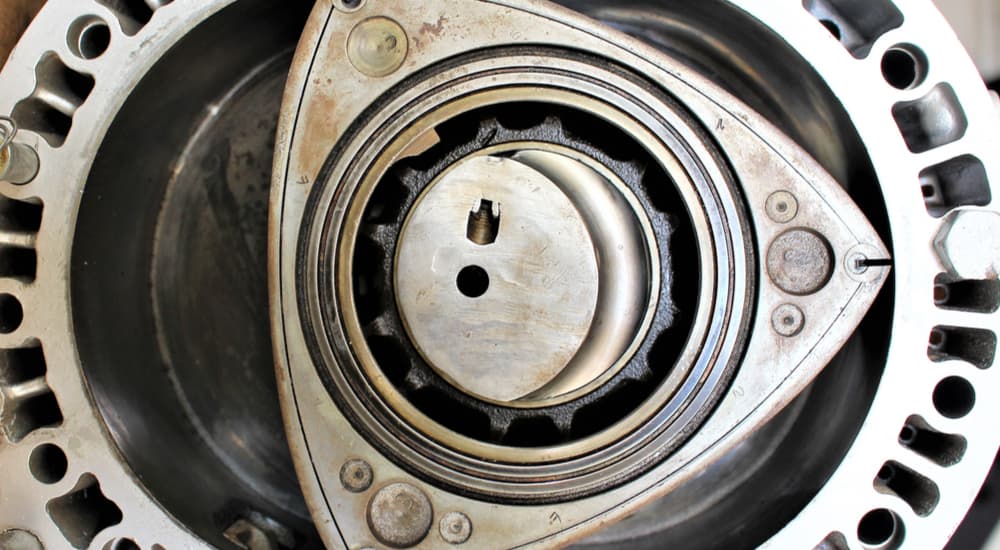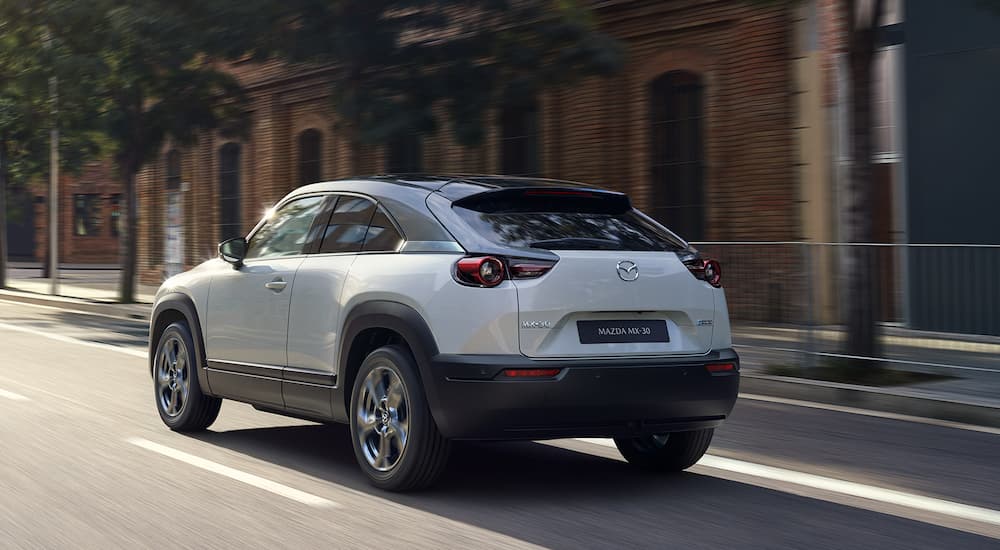If you’re a big fan of somewhat esoteric auto engine options, or you’re particularly into Mazda as a company, then you might’ve heard of a rotary engine before. For everyone else, however, the rotary engine is likely a bit of mechanical trivia you’ve never heard of – but it’s something that I think is worth knowing about. It’s a fascinating alternative to the typical piston engine that the vast majority of vehicles use – the standard for an Internal Combustion Engine (ICE). While the rotary hasn’t always been particularly popular in the past, for several reasons, it will soon find a new use in the upcoming Mazda MX-30 Plug-In Hybrid Electric Vehicle (PHEV).
What is a Rotary Engine?
You’ll see it called a Wankel engine, a rotary engine, or a Wankel rotary engine; no matter the name, however, it’s essentially the same thing. First conceived and designed by a German engineer named Felix Wankel in the 1920s, the eponymous Wankel engine uses a rotational design completely devoid of pistons like a standard ICE uses. The basic concept has been improved upon and altered a bit over the years, but it still functions in essentially the same way as Wankel envisioned.
When viewed from the end, a rotary engine is essentially a large housing that has a sort of “pill” shape – it’s an oblong with two longer sides and a rounded top and bottom. Within this housing is a triangular rotor – the sides of the triangle are curved slightly rather than being straight, which allows the sides to get very close to the insides of the housing. This triangle within the elliptical chamber can fully rotate and take advantage of the space in some very important ways.
Within the triangular rotor, there’s also an output shaft, which is rotated by the rotor – this is what delivers energy from the engine to the rest of the vehicle. A standard piston engine creates energy that is reciprocating (from the piston going up and down in the cylinder), which has to be turned into a rotational force through the use of a crankshaft. With a rotary engine, the energy from the rotary motion of the engine doesn’t need to change; it remains rotational as it’s sent to the wheels. Gearing is still needed to increase the force overall, but otherwise, it’s a lot simpler.
How Does a Rotary Engine Work?
Despite some significant differences in how they are designed, rotary engines function surprisingly similarly to piston engines. They use the same four-stroke Otto cycle that a piston engine uses to create power, but there are some very important differences in how these occur. The four stages of the rotary cycle are:
- Intake – A drop in pressure inside the housing draws in an air-fuel mixture.
- Compression – The triangular rotor draws the air-fuel mixture into a smaller area, compressing it.
- Combustion – One or more spark plugs cause combustion of the highly-compressed mixture. This causes a rapid increase in pressure and temperature, exerting a force on the rotor, which is passed to the output shaft.
- Exhaust – The expanding gases that drive the rotor then move to an exhaust port, and they’re released through an exhaust system.
What really sets a rotary engine apart, however, is that all four stages of the Otto cycle are happening simultaneously. Because each part happens in a different area within the chamber, as the triangular rotor moves, multiple stages are occurring simultaneously. With a standard piston engine, the stages occur one after another in a constant cycle – but a rotary engine doesn’t have that limitation.
The end result of this is that a rotary engine produces a great deal of rotary force in a highly efficient manner (in terms of power at least). The eccentric shaft, which is what connects to the output shaft to transfer the rotary force outside the engine, rotates three times for each time the larger, triangular rotor completes a full rotation. It’s ultimately a pretty simple and clean design for an engine with fewer moving parts than a piston engine.
Is a Rotary Engine Better than a Piston Engine?
Not really – if it was, a lot more auto manufacturers would’ve jumped onto the rotary engine hype train over the last century. There are some major advantages that a Wankel engine has over a conventional piston engine: for starters, it can be made lighter and more compact while still delivering power comparable to a larger piston engine. The efficiency with which it produces power, due to three power strokes per rotor rotation, means this kind of engine can deliver higher power output than a four-stroke piston engine.
Perhaps the biggest advantage that a rotary engine has, however, is that it lacks the reciprocating action of a piston engine. A standard ICE found in vehicles today is constantly shaking and vibrating due to the pistons moving up and down within their cylinders. Since a Wankel engine lacks this piston motion, it operates much more smoothly, and driving a car with this sort of engine is often far more comfortable, especially when you’re really pushing the engine.
So why aren’t all vehicles using a rotary engine? They have some substantial downsides; for starters, a Wankel engine has very low thermal efficiency and pretty poor burning of the fuel-air mixture. This means that rotary engines tend to have higher emissions than piston engines – and as every government has cracked down on emissions over the last few decades, it has made rotary engines very impractical. Oil also needs to be injected into the housing chamber of a Wankel engine while it runs, so they require a lot more motor oil than piston engines.
Uses in the Auto Industry
Despite the drawbacks, there have been several attempts by car manufacturers to utilize a rotary engine rather than a conventional piston model. Brands like Alfa Romeo, Ford, GM, and Mazda have licensed the Wankel engine design to see how well they could make one work in a consumer vehicle. Of the various attempts over the decades, Mazda has had the largest success and developed several sports cars over the years using a rotary engine – most notably, the RX-7 and RX-8. But the RX-8 went out of production in 2012, and there hasn’t been a mass-market vehicle with a Wankel engine since.
The Mazda MX-30 PHEV
All of that’s about to change, however, as Mazda has announced that the Plug-In Hybrid version of their MX-30 electric SUV will feature a rotary engine – in part, at least. The standard EV model of the MX-30 has a lot of people excited, but its biggest drawback is that it only has a 100-mile range with a full charge. For its PHEV version of the MX-30, Mazda is using a rotary engine as a range extender that can recharge the battery on the go. This utilizes the high efficiency of a Wankel engine, but without relying on it completely, so the design takes advantage of its strengths and gets around its weaknesses.
At the moment, that’s about all that’s known regarding the MX-30 PHEV and how its rotary engine will work – full specs should be available sometime in the coming year. There’s also a lot of potential for the use of rotary engines with hydrogen fuel, but that’s a much more specialized and niche use than we’re likely to see in the auto industry. If the rotary engine works out for the MX-30 PHEV, then we could see wider use of this type of range extender on similar models from other manufacturers. Just how well it will function remains to be seen, but it’s great to see such a unique engine get a second chance in a new setup.






